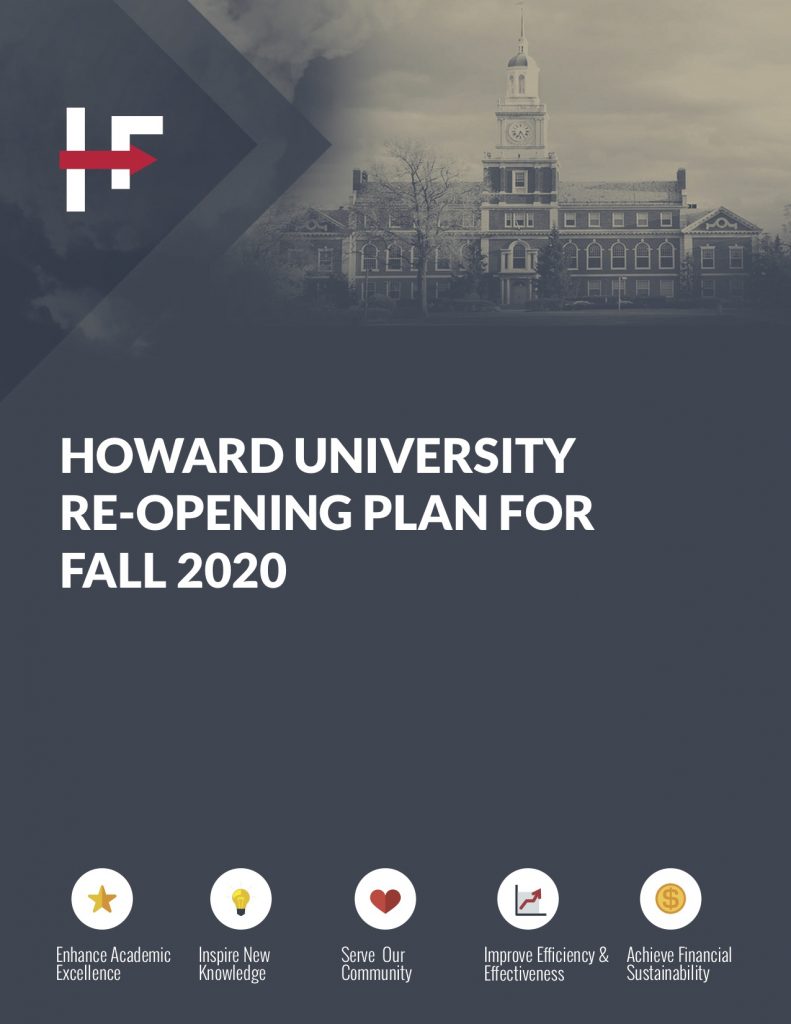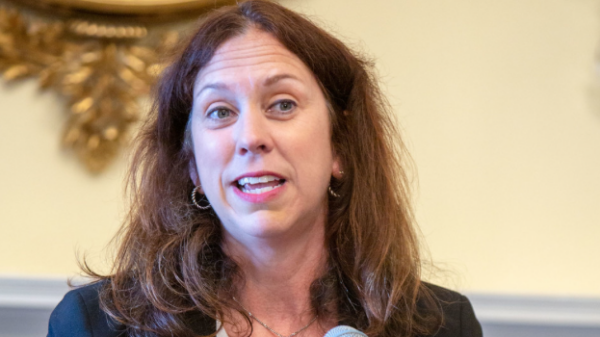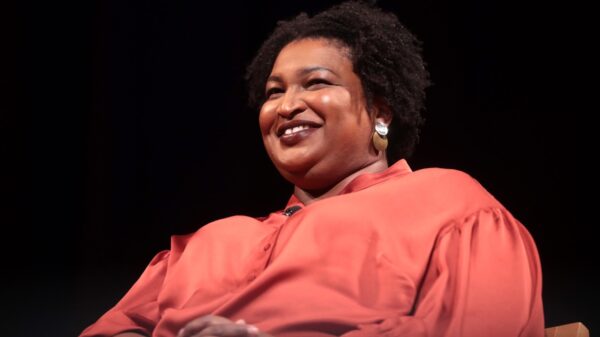By Semira Robinson, Staff Reporter

Howard University hosted a Zoom webinar on July 7 to debrief the reopening plan that was sent out to the university community via email on June 25, 2020. Anthony Wutoh, the Provost and Chief Academic Officer, presented a detailed powerpoint and moderated a panel of three Howard faculty members and a student representative. The topics covered included housing adjustments, tuition costs, course mediums and most importantly the health guidelines that will be set in place on campus to ensure the safety of every student, staff and faculty member.
The video presentation began with Wutoh guiding students through a breakdown of the plan that was sent. There were four principles the university is following as a guide which is the health and safety of the Howard community at the utmost importance, transparency when communicating any ongoing developments, data-informed based evaluations that are made by the CDC, Department of Health and public health officials, as well as to deliver the same level of quality education despite limitations cause by COVID-19.
“Please be flexible with us as we try to provide flexibility to our students and faculty,” Wutoh said.
Wutoh emphasized for the viewers at home that this plan specifically acknowledges the undergraduate student population, therefore other higher education programs may be required to follow different guidelines. All students, faculty and staff will also attend a non-optional virtual orientation that will cover the required health and safety procedures prior to arriving on campus this fall.
Personal protective equipment (PPE), is an aspect of re-opening that was highlighted numerous times and will be crucial to the community’s overall wellbeing. Everyone who will reside or work on campus must provide their negative COVID-19 test results no more than seven days prior to one’s return to campus.
Frequent retesting and screenings will be mandatory depending on feedback from health experts and the level of risk of contracting the virus as time goes on. Given that D.C. is currently in phase 2 of reopening, the university will conduct a 25% capacity in building and 15-20% capacity within dining halls until allowed otherwise. Additional social distancing measures have been taken in the residence halls and classrooms to help prevent exposure or an outbreak on campus.
When The Hilltop spoke to students about the university’s reopening plan, some were unsure about returning to campus.
“At first when I first read over the HU reopening plan. I was excited! I am a transfer and new student and what new student wouldn’t want to get the full college experience? I had already moved to D.C. to prepare for the upcoming school year, there was no backing out.“I had really been hoping for a reopening plan for Howard since March but as time progresses I soon realize that their reopening plan, though diligently planned it’s not a viable solution to keep every single person safe,” said Maya Billingsley, a junior fashion design major.
Tayelor Miller, a junior media management major also shared her concerns regarding the containment of the virus.
“I am honestly nervous about going back. In my state of Texas the cases keep rising and our leadership continues to fail to keep us safe. How are we going to social distance if we’re all going to be living in such close quarters? Keeping the virus contained is going to be proved as difficult because Howard can’t control what students do off campus,” Miller said.
The university does not encourage high risk individuals to attend face to face classes, but rather defer to exclusively online programs for the fall semester. High risk individuals could be faculty or students with conditions such as diabetes, respiratory illness, immunocompromised, heart, liver, kidney, sickle cell, and other diseases.
Given the stress, turmoil and trauma that this pandemic and recent police brutality has provoked, Wutoh acknowledged the mental health resources that students can refer to virtually which is accessible through the university website.
After Wutoh presented the slide show, he introduced Rachel Howell, Kenneth Holmes, Dr. Tashni Dubroy and Dr. Pamela Carter-Nolan for a panel discussion to further elaborate the re-opening plan. It should be noted that the majority of the university’s plan changes moving forward are dependent on the approval of the DC government, which has yet to reply to the university with an evaluation of the reopening plan.
A significant factor of the virus affecting a large amount of the university community will depend on people taking accountability for themselves and being responsible and respectful with how they interact with others on campus.
“This is the time to turn a tragedy into something great,” Rachel Howell said. Howell, a senior political science major serves as president of the Howard University Student Association in representation of the student body.
A large concern that she and many other students share is the recent announcement by ICE that all international students would be required to leave the United States if they are taking exclusively online classes.
“I feel for the vulnerable students and those who rely on Howard being open to escape dangerous and violent homes and areas. I want to be able to help out as a Student Ambassador, especially [for] my fellow LGBTQ+ students for whom I represent and plan to continue advocating for,” Moses Bossenbroek, a senior musical theatre major said.
Howard University is in contact with state officials to receive additional information and solutions to this recent dilemma, given that this will impact numerous international students negatively. The university stands with its students in solidarity in this matter and claims to work towards additional clarity to ensure the wellbeing of its international students.
Student housing is a concern or a relief, especially to students who may be freshman or upperclassmen. Kenneth Holmes described the adjustments that the Office of Residence Life has made to ensure that on-campus housing will remain a comfortable and secure.
Approximately 175 isolation rooms have been reserved on campus in the case that students begin to contract COVID-19. In this case a student will be self-quarantining in an isolation room until they recover. Given that 80% of the dorms are being used and are at full capacity, there will be an extensive 10 day move in process beginning August 14, 2020.
Students will receive a package or email to further explain the move in procedure. If there are students who are struggling to adhere to the health guidelines set in place, they will be required to leave their on campus residency and “there will be no second chances”.
When addressing the debate of whether or not Howard should or will decrease the cost of tuition, Dr. Tashni Dubroy reminded the audience of the webinar that if tuition is reduced it will reduce the quality of our education whether it is exclusively online or hybrid. Tuition accounts for 20% of the university’s revenue meaning, a reduction in tuition costs would cause staff reductions, a halt on-campus construction projects and student organization and program funding.
Dubroy also reminded attendees that asymptomatic people need to be aware of their conditions. She informed those in attendance that if you get tested on campus you will need to be in isolation until you get your results which will be at least 24 hours. it will likely take longer to receive results if there is an overwhelming amount of students testing on campus simultaneously. If possible, look for other areas where you can get COVID-19 testing nearby campus prior to arriving on campus and if you are feeling symptoms.
Dr. Pamela Carter-Nolan spoke of three key elements that we should all utilize constantly: wear your mask correctly, wash your hands every 30 minutes, and social distance at least six feet.
Carter-Nolan explained that the reasoning behind the semester ending face to face instruction on November 24 is because that is around the time that influenza season begins, therefore heightening a student’s risk of contracting an illness.
“I have my reservations about returning to campus. Though the state I live in, New York, has gotten the number of cases under control, students are coming from all over the country where circumstances are different. I also have many questions. Are we returning to campus because it’s safe or because it’s better for Howard financially? How are professors planning to accommodate students on campus? Overall, I am praying for a safe and successful semester,” Siobhan Delaney, a junior health education major, said.
There will be a frequently asked questions page posted on the university’s website soon. On July 15, students will receive an update regarding which courses are available online or face to face, the majority of the courses will be available online even if they are available face to face.









